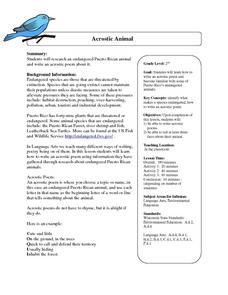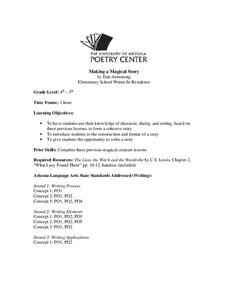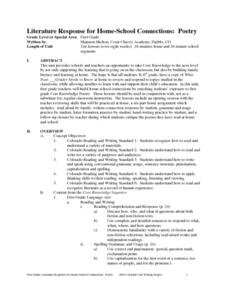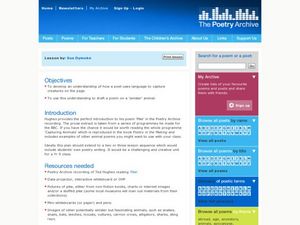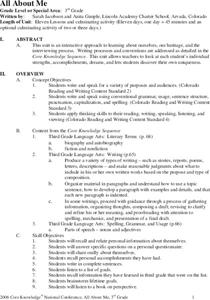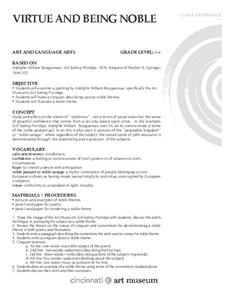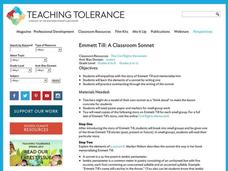National Museum of the American Indian
Fritz Scholder: A Study Guide
In this engaging activity involving close analysis of abstract expressionist art, your class members will not only discover more about artist Friz Scholder's Native American art, but they will also have the opportunity to consider...
Curated OER
Beowulf: Songs of Ancient Heroes
Introduce your class to epic heroes with these activities for Beowulf. After watching a video clip, taking notes on heroes, and tracking characteristics of heroism throughout Beowulf, class members retell an episode of Beowulf using a...
Curated OER
Archetypal Images and Polarities
Here is a rather esoteric resource that presents the archetypes found in “The Epic of Gilgamesh,” and would be appropriate for a college-level psychology or literature class, or as a teacher resource. Considered the “world’s oldest...
Curated OER
Magical Creatures Land
The opening of J.R.R. Tolkein’s The Hobbit provides a model of how to use rich details to create a setting. After reading the description of Bilbo Baggins’ abode, young writers create their own magical home for a fantasy creature. The...
Curated OER
Acrostic Animal
Second graders listen as the teacher describes how an acrostic poem is written. They research an endangered animal of Puerto Rico. Students write an acrostic poem as a class, and then individually about the animal they research. Students...
Curated OER
Praise for a Color
Students discover the 5 senses by analyzing poetry. In this poetry instructional activity, students read a poem with their class and analyze how each sense plays into their understanding of the poem. Students write a poem...
Curated OER
Magical Creatures
Students investigate entertaining characters within stories. In this writing lesson plan, students review nouns and adjectives and discuss magical characters. Students ask themselves questions about their selected characters and...
Curated OER
Making a Magical Story
Students create their own magical story. In this story writing lesson, students listen to the story The Lion, The Witch, and the Wardrobe b C.S. Lewis to find the basic elements of a story. They come up with their own magical...
Curated OER
Making a Magical Story
Fourth and fifth graders use their knowledge of developing character, dialogue, and setting to produce an original story. An excerpt from The Lion, The Witch, and The Wardrobe is used as inspiration to get everyone's...
Curated OER
Moon
Students discover scientific facts about the Moon and how
some American Indian Tribes used the moon to measure time.
They accomplish this by listening to stories and poetry, writing
stories, communicating with an astronaut,...
Curated OER
Poetry on the Web
Eighth graders search a website and locate a poem written by a specific poet whose work appears in the grade 8 anthology. After listening to poetry, 8th graders present oral or written examples of imagery and an analysis of the imagery.
Curated OER
Who Am I? (Intermediate Grades)
Students write "Guess Who?" poems in a descriptive manner. They listen to the poems as they are read aloud and try to guess who the poem belongs to.
Curated OER
Literature Response for Home-School Connections: Poetry
First graders practice reading and writing for a variety of purposes and audiences. Ten lessons on one page.
Curated OER
Sun and Moon Poetry Baskets
Students write Sun and Moon poetry. In this poetry lesson, students research the sun and the moon. They write poetry and create two class baskets for descriptive words about each.
Curated OER
Ted Hughes "Pike"
Middle schoolers analyze how a poet uses language to capture creatures and draft a poem on a 'sinister' animal. In this poetry analysis lesson, students read Ted Hughes' poem 'Pike' and analyze pictures of pike fish. Middle schoolers use...
Curated OER
Poetry Continued
Learners are introduced to the elements in poetry. After listening to music, they discuss how it made them feel and what the lyrics mean to them. Individually, they are given specific elements to write their poem and share it with the...
Curated OER
All About Me
Students write a paragraph, make lists, draw, and brainstorm things about themselves, their goals, and their past. In this all about me lesson plan, students recall information about themselves, and interview others in order to write...
Curated OER
Can You Haiku?
Everyone loves haikus! They're short, quick, and fun to write! Analyze the rules and conventions of haiku. Readers interpret examples of haiku and develop a vocabulary for writing haiku. Then they compose a haiku based on a personal...
Curated OER
Virtue And Being Noble
Young scholars write and illustrate original cinquains based upon the ideas of nobility and virtue. The activity includes a vocabulary list of key terms and rubric for student reflection and assessment. This is intended for a 4th through...
Curated OER
Emmett Till: A Classroom Sonnet
Who is Emmet Till? An important historical figure, your kids will be shocked by his story! Discover the details of his life and collaborate to write a crown of sonnets in the style of Marilyn Nelson.
Curated OER
Sonnets
Explore the concept of rhyme scheme within a Shakespearean sonnet. After writing out their favorite (appropriate!) rap song and explaining why they like it, middle schoolers define a rhyme scheme. Afterward, they examine a Shakespearean...
Curated OER
Lesson Plan 2: So What's a Novel, Anyway?
What makes a novel a novel? Class members select a favorite novel, record their impressions on a worksheet, and then come together in groups to discuss the elements common to narrative writing. Next, they identify the characters, the...
Curated OER
The Odyssey Lesson 6
"How are belief systems represented and reproduced through nature?" This essential question guides lesson 6 of this unit on The Odyssey (the rest of the unit is linked). Students first write about a scenario in which they are...
University of Arizona
Identity Repair
In a detailed, creative writing task, potential poets analyze how race, identity, and society categorize and (mis)represent us. The learning begins with an imaginative anticipatory set where learners describe unique situations that...




